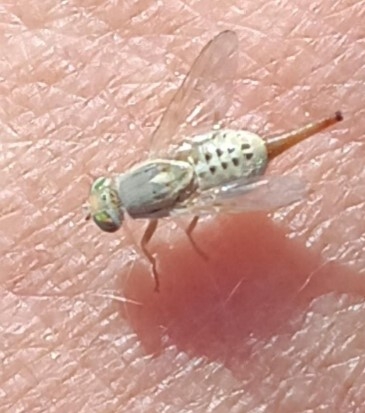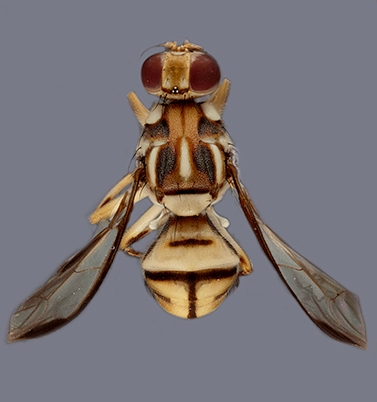
Not All Fruit Flies Are Alike
On July 30th the Queensland Fruit Fly (Qfly) quarantine was lifted in Ventura County. Qfly is part of the Tephritidae family of flies.
The Tephritidae are one of two fly families referred to as fruit flies, the other family being the Drosophilidae. Drosophila melanogaster is the fruit fly of famous biological studies to figure out how cells and genetics work. Tephritidae contain most of the flies that cause economic damage to crops because some feed on living tissue, they go after fresh fruit. To distinguish them from the Drosophilidae, the Tephritidae are sometimes called peacock flies, in reference to their elaborate and colorful markings. The Artichoke fruit fly (Terellia fuscicornis) has a limited diet, going after artichoke and presumably other thistles, so it's impact is small unless you are an artichoke grower. Spotted-Wing Drosophila (Drosophila suzukii ) which goes after soft fruits like blueberries, raspberries and strawberries can be a major economic problem, but generally Drosophilidae feed on pollen and rotting material. They are generally nuisance flies.
Some Tephritidae have negative effects, some positive. Various species of fruit flies cause damage to fruit and other plant crops. The genus Bactrocera is of worldwide notoriety for its destructive impact on agriculture. The olive fruit fly (B. oleae), for example, feeds on only one plant: the wild or commercially cultivated olive, Olea europaea. It has the capacity to ruin 100% of an olive crop by damaging the fruit. Bactrocera dorsalis is another highly invasive pest species that damages tropical fruit, vegetable, and nut crops.Euleia heraclei is a pest of celery and parsnips. The genus Anastrepha includes several important pests, notably A. grandis, A. ludens (Mexican fruit fly), A. obliqua, and A. suspensa. Other pests are Strauzia longipennis, a pest of sunflowers and a pest of blueberries. https://ucanr.edu/blogs/blogcore/postdetail.cfm?postnum=60063
Another notorious agricultural pest is the Mediterranean fruit fly or Medfly, Ceratitis capitata, which is responsible for millions of dollars' worth in expenses by countries for control and eradication efforts, in addition to costs of damage to fruit crops. Similarly, the Queensland fruit fly (Bactrocera tryoni) is responsible for more than $28.5 million in damage to Australian fruit crops a year. This species lays eggs in a wide variety of unripe fruit hosts, causing them to rot prior to ripening. The Tau fruit fly (Bactrocera tau) or pumpkin fruit fly, goes after melons and other cucurbits like cucumbers and squash. The oriental fruit fly (Bactrocera dorsalis) has been seen in more than 200 kinds of fruit and nut plants.
Med, Mex, Oriental and Tau have all been in the news lately because of quarantines to contain their spread. The bulk of fruit flies, though don't pose a threat to agriculture, including all 1,500 species of Drosophilidae and the 5,000 species of Tephritidae.
Artichoke Fruit Fly - a drosophila
Tau Fruit Fly - a tephritid


